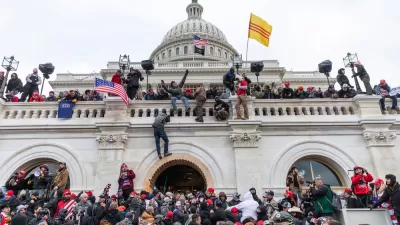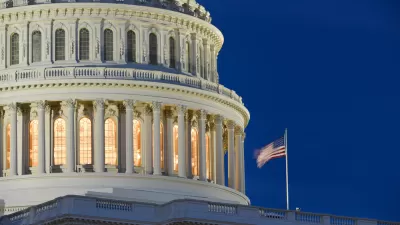The potential of the Infrastructure Investment and Jobs Act is most unrealized as the federal government mobilizes the details of the $1.2 trillion bill. President Joe Biden signed the bill in November 2021.

Writing for Route Fifty, Kery Murakami checks in with the Infrastructure Investment and Jobs Act (IIJA), a year after the historic $1.2 trillion bill was approved by Congress and signed into law by President Joe Biden. On one hand, reports Kurakami, local officials tout the bill’s potential to improve long-neglected infrastructure around the country. On the other hand, “changes are needed to help with the rollout of all the new funding, including speeding up permitting for transportation projects and making it simpler for local governments to apply for the grants,” writes Murakami.
The article digs specifically into some of the specific details of permitting requirements, especially under the National Environmental Policy Act (NEPA). The IIJA made tangible changes to the NEPA process, including a requirement for “federal agencies to consider the ‘indirect’ and ‘cumulative’ environmental effects of projects and not just the direct ones.” Republicans will try to undo those changes, reports Murkami. The IIJA also added the One Federal Decision, “which requires federal agencies to coordinate their environmental reviews.”
Sources cited in the article include U.S. Senator Ben Cardin (D-Maryland); U.S. Senator Kevin Cramer (R-North Dakota); Jim Willox, chairman of the Converse County Commission in Wyoming; Michael Carroll, deputy managing director of the Philadelphia Office of Transportation and Infrastructure Systems; and Jacob Day, mayor of Salisbury, Maryland.
While the article also mentions a few specific programs funded by the IIJA, like Buy America requirements, $5 billion to install electric vehicle charging infrastructure, and the Transportation Alternatives program (doubled by the IIJA), most of details of implementation remain conceptual, and have yet to materialize in tangible, built projects.
FULL STORY: The Infrastructure Law, One Year In

Alabama: Trump Terminates Settlements for Black Communities Harmed By Raw Sewage
Trump deemed the landmark civil rights agreement “illegal DEI and environmental justice policy.”

Study: Maui’s Plan to Convert Vacation Rentals to Long-Term Housing Could Cause Nearly $1 Billion Economic Loss
The plan would reduce visitor accommodation by 25% resulting in 1,900 jobs lost.

Planetizen Federal Action Tracker
A weekly monitor of how Trump’s orders and actions are impacting planners and planning in America.

Wind Energy on the Rise Despite Federal Policy Reversal
The Trump administration is revoking federal support for renewable energy, but demand for new projects continues unabated.

Passengers Flock to Caltrain After Electrification
The new electric trains are running faster and more reliably, leading to strong ridership growth on the Bay Area rail system.

Texas Churches Rally Behind ‘Yes in God’s Back Yard’ Legislation
Religious leaders want the state to reduce zoning regulations to streamline leasing church-owned land to housing developers.
Urban Design for Planners 1: Software Tools
This six-course series explores essential urban design concepts using open source software and equips planners with the tools they need to participate fully in the urban design process.
Planning for Universal Design
Learn the tools for implementing Universal Design in planning regulations.
Caltrans
Smith Gee Studio
Institute for Housing and Urban Development Studies (IHS)
City of Grandview
Harvard GSD Executive Education
Toledo-Lucas County Plan Commissions
Salt Lake City
NYU Wagner Graduate School of Public Service





























